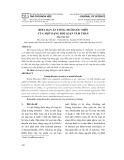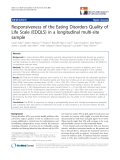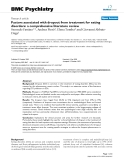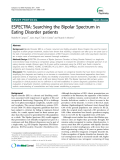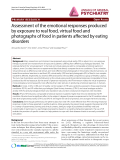
Eating disorders
-
Rối loạn ăn uống (EDs) lại hết sức phức tạp về triệu chứng, ảnh hưởng, nguyên nhân, và cả các cách tiếp cận điều trị. Bài viết tổng hợp, phân tích, và thực hiện các đánh chuyên sâu hơn về rối loạn ăn uống nhằm hệ thống hóa vấn đề dưới góc nhìn đa chiều về tình trạng này.
 9p
9p  tieuthi3006
tieuthi3006
 16-03-2018
16-03-2018
 62
62
 2
2
 Download
Download
-
Tài liệu Các chứng rối loạn ăn uống ở Úc trình bày định nghĩa về chứng rối loạn ăn uống, nguyên nhân gây ra chứng rối loạn ăn uống, những dấu hiệu và triệu chứng của chứng rối loạn ăn uống, thực trạng phổ biến của chứng rối loạn ăn uống và những tác động của chứng rối loạn ăn uống đối với xã hội Úc.
 5p
5p  roongkloi00
roongkloi00
 07-08-2017
07-08-2017
 71
71
 2
2
 Download
Download
-
Tuyển tập báo cáo các nghiên cứu khoa học quốc tế ngành y học dành cho các bạn tham khảo đề tài: Responsiveness of the Eating Disorders Quality of Life Scale (EDQLS) in a longitudinal multi-site sample
 11p
11p  panasonic05
panasonic05
 23-12-2011
23-12-2011
 58
58
 4
4
 Download
Download
-
Factors associated with dropout from treatment for eating disorders: a comprehensive literature review
 9p
9p  thulanh29
thulanh29
 18-12-2011
18-12-2011
 51
51
 3
3
 Download
Download
-
Erratic eating is one of the manifestations of mental disorders. Patients can not eat or drink, or eating too much can not be controlled.For mental health care possible, it is important to reserve the disease, early detection and treatment of disorders to prevent complications, and rehabilitation for patients with community reintegration. However, psychiatric symptoms were relatively discreet, sometimes hard to distinguish from the normal operation
 10p
10p  thulanh29
thulanh29
 17-12-2011
17-12-2011
 55
55
 2
2
 Download
Download
-
Tuyển tập báo cáo các nghiên cứu khoa học quốc tế ngành y học dành cho các bạn tham khảo đề tài: ESPECTRA: Searching the Bipolar Spectrum in Eating Disorder patients
 5p
5p  thulanh29
thulanh29
 17-12-2011
17-12-2011
 46
46
 3
3
 Download
Download
-
Tuyển tập các báo cáo nghiên cứu về y học được đăng trên tạp chí y học General Psychiatry cung cấp cho các bạn kiến thức về ngành y đề tài: Assessment of the emotional responses produced by exposure to real food, virtual food and photographs of food in patients affected by eating disorders...
 10p
10p  thulanh11
thulanh11
 10-10-2011
10-10-2011
 33
33
 2
2
 Download
Download
-
Drugs that act upon the central nervous system (CNS) influence the lives of everyone, every day. These agents are invaluable therapeutically because they can produce specific physiological and psychological effects. Without general anesthetics, modern surgery would be impossible. Drugs that affect the CNS can selectively relieve pain, reduce fever, suppress disordered movement, induce sleep or arousal, reduce the desire to eat, or allay the tendency to vomit. Selectively acting drugs can be used to treat anxiety, mania, depression, or schizophrenia and do so without altering consciousness....
 389p
389p  vanass
vanass
 01-04-2011
01-04-2011
 106
106
 10
10
 Download
Download
-
Recurrent episodes of binge eating, which is characterized by the consumption of a large amount of food in a short period of time and a feeling that the eating is out of control. Recurrent inappropriate behavior to compensate for the binge eating, such as self-induced vomiting. The occurrence of both the binge eating and the inappropriate compensatory behavior at least twice weekly, on average, for 3 months. Overconcern with body shape and weight.
 6p
6p  konheokonmummim
konheokonmummim
 03-12-2010
03-12-2010
 59
59
 4
4
 Download
Download
-
An algorithm for basic treatment decisions regarding patients with anorexia nervosa or bulimia nervosa. Based on the American Psychiatric Association's practice guidelines for the treatment of patients with eating disorders.
 5p
5p  konheokonmummim
konheokonmummim
 03-12-2010
03-12-2010
 49
49
 2
2
 Download
Download
-
Refusal to maintain body weight at or above a minimally normal weight for age and height. (This includes a failure to achieve weight gain expected during a period of growth leading to an abnormally low body weight.) Intense fear of weight gain or becoming fat. Distortion of body image (e.g., feeling fat despite an objectively low weight or minimizing the seriousness of low weight). Amenorrhea. (This criterion is met if menstrual periods occur only following hormone—e.g., estrogen—administration.
 5p
5p  konheokonmummim
konheokonmummim
 03-12-2010
03-12-2010
 63
63
 4
4
 Download
Download
-
Physical Features Patients with AN typically have few physical complaints but may note cold intolerance. Gastrointestinal motility is diminished, leading to reduced gastric emptying and constipation. Some women who develop AN after menarche report that their menses ceased before significant weight loss occurred. Weight and height should be measured to allow calculation of body mass index (BMI; kg/m2). Vital signs may reveal bradycardia, hypotension, and mild hypothermia. Soft, downy hair growth (lanugo) sometimes occurs, and alopecia may be seen.
 5p
5p  konheokonmummim
konheokonmummim
 03-12-2010
03-12-2010
 72
72
 3
3
 Download
Download
-
Table 76-1 Common Characteristics of Anorexia Nervosa and Bulimia Nervosa Anorexia Nervosaa Bulimia Nervosa Clinical Characteristics Onset Mid-adolescence Late adolescence/early adulthood Female:male 10:1 10:1 Lifetime prevalence 1% 1–3% in women Weight Markedly decreased Usually normal Menstruation Absent Usually normal Binge eating 25–50% Required diagnosis for Mortality 5% per decade Low Physical and Laboratory Findingsa Skin/extremities Lanugo Acrocyanosis Edema Cardiovascular Bradycardia Hypotension Gastrointestinal Salivary enlargement gland S...
 5p
5p  konheokonmummim
konheokonmummim
 03-12-2010
03-12-2010
 70
70
 4
4
 Download
Download
-
Harrison's Internal Medicine Chapter 76. Eating Disorders Eating Disorders: Introduction Anorexia nervosa and bulimia nervosa are characterized by severe disturbances of eating behavior. The salient feature of anorexia nervosa (AN) is a refusal to maintain a minimally normal body weight. Bulimia nervosa (BN) is characterized by recurrent episodes of binge eating followed by abnormal compensatory behaviors, such as self-induced vomiting. AN and BN are distinct clinical syndromes but share certain features in common.
 5p
5p  konheokonmummim
konheokonmummim
 03-12-2010
03-12-2010
 56
56
 3
3
 Download
Download
-
ANORECTAL AND PELVIC FLOOR TESTS Pelvic floor dysfunction is suggested by the inability to evacuate the rectum, a feeling of persistent rectal fullness, rectal pain, the need to extract stool from the rectum digitally, application of pressure on the posterior wall of the vagina, support of the perineum during straining, and excessive straining. These significant symptoms should be contrasted with the sense of incomplete rectal evacuation, which is common in IBS.
 5p
5p  ongxaemnumber1
ongxaemnumber1
 29-11-2010
29-11-2010
 71
71
 5
5
 Download
Download
-
FACTITIAL CAUSES Factitial diarrhea accounts for up to 15% of unexplained diarrheas referred to tertiary care centers. Either as a form of Munchausen syndrome (deception or self-injury for secondary gain) or eating disorders, some patients covertly selfadminister laxatives alone or in combination with other medications (e.g., diuretics) or surreptitiously add water or urine to stool sent for analysis. Such patients are typically women, often with histories of psychiatric illness and disproportionately from careers in health care.
 5p
5p  ongxaemnumber1
ongxaemnumber1
 29-11-2010
29-11-2010
 65
65
 5
5
 Download
Download
-
Harrison's Internal Medicine Chapter 30. Disorders of Smell, Taste, and Hearing Smell The sense of smell determines the flavor and palatability of food and drink and serves, along with the trigeminal system, as a monitor of inhaled chemicals, including dangerous substances such as natural gas, smoke, and air pollutants. Olfactory dysfunction affects ~1% of people under age 60 and more than half of the population beyond this age. Definitions Smell is the perception of odor by the nose. Taste is the perception of salty, sweet, sour, or bitter by the tongue.
 6p
6p  ongxaemnumber1
ongxaemnumber1
 29-11-2010
29-11-2010
 91
91
 7
7
 Download
Download
CHỦ ĐỀ BẠN MUỐN TÌM








